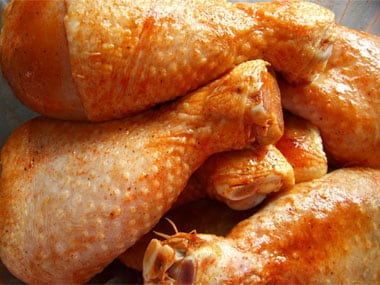In a bid to offer some protection to the growing domestic poultry industry from competitively priced American chicken legs, the Indian government is all set to ban frozen chicken older than six months, as well as those that have fed growth hormones, antibiotics or genetically modified feed.
According to a report in the Economic Times
, the new standards meant to tighten the norms for import of American chicken legs will kick in within the next six months. The World Trade Organisation had recently ruled against India’s ban on chicken import from the US imposed on account of avian influenza in 2007, calling it ‘unscientific’ and non-compliant with the global trade body’s rules. The Commerce Ministry has now asked local poultry breeders to work out fresh risk assessments that would better withstand scientific scrutiny.The Indian government has time till 26 January to respond to WTO’s ruling. [caption id=“attachment_2058975” align=“alignleft” width=“380”]
 Wikipedia Commons[/caption] US chicken legs are priced much lower than ones from India as chicken legs have no viable market in the US, where consumers prefer white meat like chicken breast and consider legs as ‘harmful’ red meat. So the unwanted frozen chicken legs are exported at throw away prices to Central Asia, with India potentially being one such country. In India, chicken legs are priced locally at about Rs 150-170 per kg, while the US sells them at Rs 40-50 per kg. But given that the domestic poultry industry fears that allowing free import of chicken legs would be detrimental to their interest as it will eventually wipe out our small farmers and the nascent industry, India currently has a 100 percent import tariff on cut chicken (chicken legs) and 30 percent tariff on non-cut chicken.
According to a report in the Hindu Business Line
, the commerce ministry believes it will have a better chance of retaining the import ban if it can issue fresh orders based on a more valid health concern. Due to this risk assessment is being done on factors such as US poultry being fed genetically modified food or the fact that frozen chicken is kept in that state for long periods.
Another report in Economic Times
suggests India could look at options such as anti-dumping duties but it will have to allow US chicken for a year to assess the dumping margin or else dumping analysis can be done by apprehending the price at which US sells to different markets. This will not be an easy task. Earlier this month, C
hina banned the import of US poultry and eggs
after the detection of an avian flu strain in the Pacific Northwest. More than 20 countries, including members of the EU, South Korea and South Africa, have imposed curbs on poultry from certain US states or the entire country.
Wikipedia Commons[/caption] US chicken legs are priced much lower than ones from India as chicken legs have no viable market in the US, where consumers prefer white meat like chicken breast and consider legs as ‘harmful’ red meat. So the unwanted frozen chicken legs are exported at throw away prices to Central Asia, with India potentially being one such country. In India, chicken legs are priced locally at about Rs 150-170 per kg, while the US sells them at Rs 40-50 per kg. But given that the domestic poultry industry fears that allowing free import of chicken legs would be detrimental to their interest as it will eventually wipe out our small farmers and the nascent industry, India currently has a 100 percent import tariff on cut chicken (chicken legs) and 30 percent tariff on non-cut chicken.
According to a report in the Hindu Business Line
, the commerce ministry believes it will have a better chance of retaining the import ban if it can issue fresh orders based on a more valid health concern. Due to this risk assessment is being done on factors such as US poultry being fed genetically modified food or the fact that frozen chicken is kept in that state for long periods.
Another report in Economic Times
suggests India could look at options such as anti-dumping duties but it will have to allow US chicken for a year to assess the dumping margin or else dumping analysis can be done by apprehending the price at which US sells to different markets. This will not be an easy task. Earlier this month, C
hina banned the import of US poultry and eggs
after the detection of an avian flu strain in the Pacific Northwest. More than 20 countries, including members of the EU, South Korea and South Africa, have imposed curbs on poultry from certain US states or the entire country.
India looks for loopholes to prevent importing American chicken legs
FP Staff
• January 22, 2015, 12:16:33 IST
In a bid to offer some protection to the growing domestic poultry industry from competitively priced American chieck legs, the Indian government is all set to ban frozen chicken older than six months as well as those that have consumed growth hormones and antibiotics or fed with genetically modified feed.
Advertisement
)
End of Article